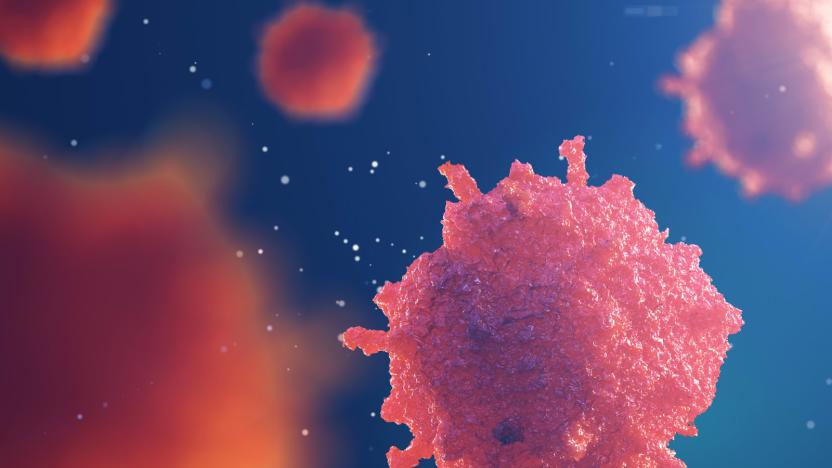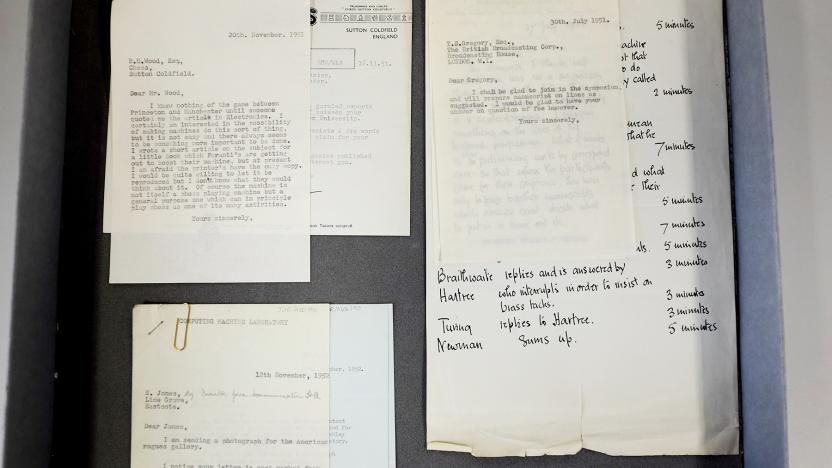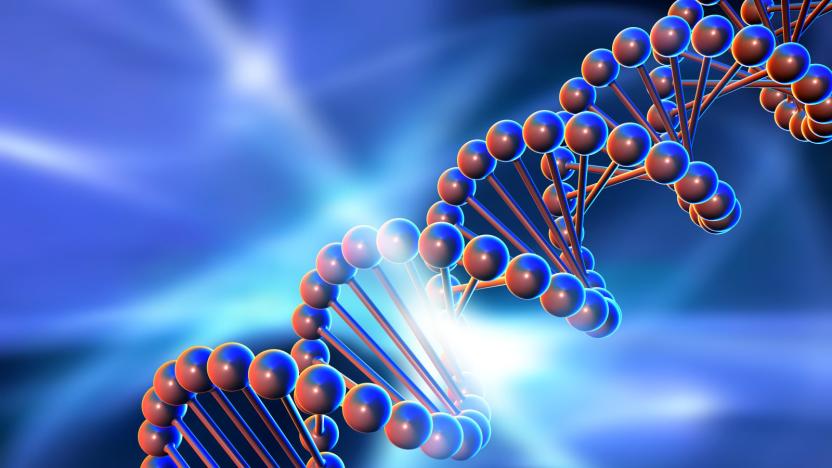universityofmanchester
Latest

Scientists study jumping spiders to create agile robots
However creepy jumping spiders might be, they're undoubtedly biomechanical marvels: they can jump up to six times their body length from a complete stop. Wouldn't that be handy for robots, which don't always have the luxury of a running start? University of Manchester researchers think so. They're using a combination of CT scans and high-speed cameras to analyze the movement of a jumping spider (affectionately named Kim) and see how it could translate to robotics. The team both captured Kim's jumps in slow motion and produced a 3D model to understand the arachnid's body and leg structure at an "unprecedented" level of detail.

Algae-based nanobots could diagnose you from the inside
Nanobots promise a breakthrough in medicine by letting doctors study and treat you without invasive surgery or relatively ineffective drugs. But they face a couple of key problems: it's not easy to steer them to where they're needed, and getting rid of them is difficult when they're finished. Researchers might have a solution: make them out of natural materials that are guaranteed to break down. They've crafted nanobots (not pictured) using the sort of spirulina algae you can find in health food stores. The natural composition not only lets them biodegrade gracefully, but makes them relatively easy to control and track.

Lost Alan Turing letters found in university filing cabinet
A huge batch of letters penned by British cryptographer Alan Turing has been found at the University of Manchester. Professor Jim Miles was tidying a storeroom when he discovered the correspondence in an old filing cabinet. At first he assumed the orange folder, which had Turing's name on the front, had been emptied and re-used by another member of staff. But a closer look revealed 148 documents, including a letter sent by GCHQ, a draft version of a BBC radio programme about artificial intelligence, and invitations to lecture at some top universities in America.

America is driving gun sales on the dark web
Sixty percent of all the weapons sold on the dark web are smuggled out of the US, according to research from the RAND Corporation. It, along with the University of Manchester, began investigating the illegal trade in firearms, explosives and ammunition available on Silk Road-esque marketplaces. The pair believe that sellers are making a killing by buying guns in the US and shipping them to Europe, where prices are higher.

Hypersonic aircraft are more realistic thanks to a ceramic coating
There are a few reasons why you aren't flying across the country in hypersonic aircraft, but the simplest of them is heat: when you travel at speeds over Mach 5, the ultra-high temperatures (around 3,600F to 5,400F) strip layers from metal. How do you protect a vehicle when even the toughest ceramic tiles can't handle those conditions? A team of British and Chinese researchers might have the answer. They've engineered a carbide-based ceramic coating that's about 12 times more effective than current ceramics, making hypersonic aircraft more realistic.

Graphene sieves are a cheaper way of making saltwater drinkable
A graphene-based sieve developed by a team of researchers from the University of Manchester could give millions of people access to clean water. See, it's highly efficient in filtering the salt out of saltwater and could lead to a less energy-intensive desalination process. The team's sieve is made of graphene oxide, an oxidized form of the material that could be easier and cheaper to produce in large quantities than the typical graphene.

Scientists prove it's possible to build a DNA computer
Scientists at the University of Manchester, led by Professor Ross D. King, have created a new DNA-based computing device. If you think of DNA as being the code for generating life, then it's not hard to see it as capable of performing other tasks. Just as the four key proteins of DNA can be combined to tell white blood cells to attack infections or grow hair, they could also theoretically be used to analyze massive amounts of climate data... or you know, render a disturbingly realistic Nazi to shoot in the face.

Alt-week 9.29.12: 3D pictures of the moon, 4D clocks and laser-controlled worms
Alt-week peels back the covers on some of the more curious sci-tech stories from the last seven days. Dimensions, they're like buses. You wait for ages, and then three come along at once. And then another one right after that. While that might be about where the analogy ends, this week sees us off to the moon, where we then leap from the third, right into the fourth. Once there, we'll learn how we could eventually be controlled by lasers, before getting up close and personal with a 300 million-year old bug. Sound like some sort of psychedelic dream? Better than that, this is alt-week.

Radio astronomy pioneer Sir Bernard Lovell dies at 98
Astronomy just lost one of its vanguards, as Sir Bernard Lovell has died at 98. The UK-born scientist was best known as a cornerstone of radio telescope development. While he wasn't the first to leap into the field, he established the University of Manchester's Jodrell Bank Observatory to study cosmic rays in 1945 and organized the construction of what would ultimately be called the Lovell Telescope -- a radio telescope so large and useful that it's still the third-largest steerable example in the world, 55 years after it was first put into action. His work helped track some of the earliest spacecraft and was instrumental in confirming the first discovered pulsars and quasars. On top of his most conspicuous achievements, Sir Lovell played an important role in developing airborne radar during World War II and was lauded for having scientific curiosity long after he hung up his Jodrell director's hat in 1980. Science will be poorer without him. [Image credit: NASA; thanks, Darren]

Graphene heals itself, powers our dreams and nightmares
Slowly, but surely graphene is pushing our technological hopes, dreams and, yes, nightmares towards reality. The stuff is capable of extending battery life, generating electricity, powering high-speed data connections and super computer-worthy CPUs. It's water proof, stretchy, bendy and apparently self healing. (This space reserved for T-1000 reference.) Researchers at the University of Manchester discovered that, if you put a hole in a sheet of graphene, it simply stitches itself back together. This is thanks to carbon's tendency to latch on to other atoms, including its own, which can make the futuristic material difficult to work with, but gives it this highly unique quality. Thankfully, we're no where near self-healing robots. But, the discovery could lead to a simple method for molding it into almost any shape. Once pierced, the form of the mend is determined by the type of molecules introduced -- pure carbon simply regrows the perfect honeycomb structure, while a few foreign atoms can lead to "defects." Of course, if they're intentional and predictable, defects merely become "features." For more check out the source link.

British researchers design a million-chip neural network 1/100 as complex as your brain
If you want some idea of the complexity of the human brain, consider this: a group of British universities plans to link as many as a million ARM processors in order to simulate just a small fraction of it. The resulting model, called SpiNNaker (Spiking Neural Network architecture), will represent less than one percent of a human's gray matter, which contains 100 billion neurons. (Take that, mice brains!) Yet even this small scale representation, researchers believe, will yield insight into how the brain functions, perhaps enabling new treatments for cognitive disorders, similar to previous models that increased our understanding of schizophrenia. As these neural networks increase in complexity, they come closer to mimicking human brains -- perhaps even developing the ability to make their own Skynet references.

Hedge fund using Twitter to predict stock prices, OK Cupid to meet girls
For some reason, we weren't surprised when Derwent Capital Markets announced plans to launch a hedge fund in February that will trade based on something called "Twitter sentiment," among other things. The science behind it comes from researchers at the University of Manchester and Indiana University, which maintains that there is a correlation between public mood and the Dow Jones industrial average. Apparently, a calm public seems to indicate that the Dow will go up, while an anxious public indicates that the Dow will go down. And according to Johan Bollen, an associate professor of informatics and computing at IU, Twitter posts can be analyzed and used to judge the public mood -- with a greater than 87 percent accuracy. Hit the source link to see him state his case.

Nokia N900 does real-time face tracking for verification (video)
In a world where smartphone unlock patterns and PINs can be easily gleaned from display muck, and computer passwords can be deciphered from the telltale audible clicks of the keyboard, it's any wonder that research is funded for alternative identity verification schemes. One promising technology is face verification -- technology we've already seen implemented in webcams, laptops, and more recently, Microsoft's Kinect for Xbox 360. Where we haven't seen it broadly deployed is in the easy-to-lose smartphone, at least not with the level of sophistication achieved by the University of Manchester (UK). Using an N900, the research team developed a prototype that quickly locks and tracks 22 facial features in real time (even when upside down) using the Nokia's front-facing camera. The Active Appearance modeling technique was developed for the EU-funded Mobile Biometrics (MoBio) project as a means of using face verification to authenticate smartphone access to social media sites. Unfortunately, there's no mention of how long Manchester's face-verified login actually takes. Nevertheless, the video, apparently shot in a steam room full of hot man smudge, is worth a peep after the break.

Scientists formalize perfect handshake; world peace on track for 2012
PH = (e² + ve²)(d²) + (cg + dr)² + π{(4< s >2)(4< p >2)}² + (vi + t + te)² + {(4< c >2)(4< du >2)}² Where (e) is eye contact (1=none; 5=direct) 5; (ve) is verbal greeting (1=totally inappropriate; 5=totally appropriate) 5; (d) is Duchenne smile - smiling in eyes and mouth, plus symmetry on both sides of face, and slower offset (1=totally non-Duchenne smile (false smile); 5=totally Duchenne) 5; (cg) completeness of grip (1=very incomplete; 5=full) 5; (dr) is dryness of hand (1=damp; 5=dry) 4; (s) is strength (1= weak; 5=strong) 3; (p) is position of hand (1=back towards own body; 5=other person's bodily zone) 3; (vi) is vigour (1=too low/too high; 5=mid) 3; (t) is temperature of hands (1=too cold/too hot; 5=mid) 3; (te) is texture of hands (5=mid; 1=too rough/too smooth) 3; (c) is control (1=low; 5=high) 3; (du) is duration (1= brief; 5=long) 3. It's that easy! Perhaps just as interesting is the fact that this formula was arrived at by University of Manchester scientists hired by Chevrolet "as part of a handshake training guide for its staff to prepare them ahead of the launch of the new 5 Year Promise offer, which aims to offer peace of mind and reassurance to its customers." Now excuse us while we go practice with our best friend for the rest of our useful lives. [Image courtesy of Aidan_Jones]

Pulsar clocks spin closer to reality
Contrary to popular legend, Pulsar wristwatches don't use the light of dying stars to keep time. However, if researchers at the University of Manchester are correct, the strobe-like effect generated by a collapsed star's spin may indeed be the most accurate clock (sorry, atoms) available to mankind. While pulsars have long been studied for insight into the nature of time and gravity, their patterns weren't as regular as scientists would like, but the U of M team believe that's because the stars are actually swapping between two different states, each with their own rotation speed. By correcting for the difference when the hunk of burning gas puts on the brakes, they can make measurements far more precise -- meaning a greater understanding of the fabric of space-time for the brainiacs, and if we're lucky, reliable pulsar clocks within our lifetime.

Researchers tout progress towards graphene-based gadgets
We've heard researchers tout the many benefits of graphene before, and it doesn't look like they're showing any signs of letting up, with a group from the University of Manchester now boasting that they've made even more progress with the material that was created only a few years ago. Specifically, they've apparently found a way to develop graphene-based films (an alternative to the current indium-based options) more cheaply by simply "dissolving" chunks of graphite into graphene and then "spraying the suspension onto a glass surface." What's more, the researchers say that there are only a "few small, incremental steps" remaining before the graphene film is ready for the mass production stage, after which they say we could be seeing graphene-based LCD products within "a few years." As you may recall, this all follows some similar developments from researchers at the Max Planck Institute in Germany, although their method apparently "involved several extra steps," and they weren't making any promises about actual products turning up anytime soon.

Researchers turn to VR to treat phantom limb pain
Researchers at the University of Manchester are turning to virtual reality once again, not to have another go 'round at proving whether telepathy is real or not, but to help individuals with amputated limbs recover from so-called "phantom limb pain," a sensation wherein amputees appear to feel pain in their lost limb. The treatment involves patients donning the requisite headgear and data gloves, allowing them to explore a virtual world with their missing limb restored. Patients then perform various tasks that trick the brain into thinking it can control the missing limb, something earlier studies suggested would help alleviate the often unbearable pain. While the study is definitely on the small side -- just five patients -- the researchers seem to be quite enthused with their findings, reporting that four of the subjects achieved significant reductions in pain, in one case after just a single session. Cause for further study, no doubt; let's just hope our British friends don't completely give up on their more esoteric endeavors.

Researchers test telepathy in virtual world
Those mad scientists at the University of Manchester are at it again, first repairing broken bones with inkjet printers, then simulating velociraptor attacks, and now trying to determine once and for all if telepathy is real -- using virtual reality, of course. About a hundred individuals are expected to take part in the experiment, which'll also test if telepathic abilities are stronger between people that already know each other. In the tests, two subjects will be placed far apart from each other, on different floors of the building (to avoid cheating), each donning VR helmets and gloves that plop then into a virtual environment. One of the individuals is then presented with an image that they're supposed to concentrate on and interact with, while the other is shown four items, from which they must pick the other person's object. We give this about an 80% chance of being inconclusive, a 10% chance of it proving that telepathy is real, and a 10% chance that things go completely haywire, giving everyone involved super telepathic abilities.









